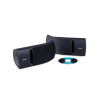Subcenter2009
Active Member
Dear friends,
Full range speakers are those whose cabinets do not have tweeters or woofers.
They may have 1 or more full range drivers or dual cone speakers.
They usually lack low end Bass extension but are usually excellent performers when mated with a suitable subwoofer or two...
Sibilance is usually minimal in these speakers.
Since there is no overlapping of frequencies as normally seen between Tweeter/midrange/woofer in cheaper 2/3 way speaker towers, sound seems more consistent and the presence is more realistic.
I will start this thread talking about the Bose 161, a true full ranger with fantastic 3 dimensional imaging. But as expected, they lack bass and require a dedicated sub with which, they are truly world class.
And, if you are going to use a subwoofer, they will not burn a hole in your wallet.
They have 2 large excursion 4" drivers in each cabinet.
But they, when installed decently, have a rare quality of beautiful 3D imaging which crossed over 2/3 way speakers really lack.
Frankly, They are among the best i have ever heard.
Now I have made a beginning.. now I welcome fellow members to post your love/hate relationships with true full rangers.
I have also heard some awesomely decent sounding dual cone driver speakers. I am including dual cone speakers in this genre.
So friends, please post your love hate relationships with fullrangers.
The Bose 201/ 301 etc are not true full rangers as they feature a tweeter. But 901 may fall into the fullranger category.
Most commonly found home theater satellites may either be full rangers or 2 way. But world beating full range speaker units are a class by themselves.
You must hear them to understand what i am raving about.
The Bose 161s are also excellent surround speakers for a home theater and are rated at 10-100 watts RMS.
.
No. I don't work for that company.. but am just an admirer of true full range speakers.
Full range speakers are those whose cabinets do not have tweeters or woofers.
They may have 1 or more full range drivers or dual cone speakers.
They usually lack low end Bass extension but are usually excellent performers when mated with a suitable subwoofer or two...
Sibilance is usually minimal in these speakers.
Since there is no overlapping of frequencies as normally seen between Tweeter/midrange/woofer in cheaper 2/3 way speaker towers, sound seems more consistent and the presence is more realistic.
I will start this thread talking about the Bose 161, a true full ranger with fantastic 3 dimensional imaging. But as expected, they lack bass and require a dedicated sub with which, they are truly world class.
And, if you are going to use a subwoofer, they will not burn a hole in your wallet.
They have 2 large excursion 4" drivers in each cabinet.
But they, when installed decently, have a rare quality of beautiful 3D imaging which crossed over 2/3 way speakers really lack.
Frankly, They are among the best i have ever heard.
Now I have made a beginning.. now I welcome fellow members to post your love/hate relationships with true full rangers.
I have also heard some awesomely decent sounding dual cone driver speakers. I am including dual cone speakers in this genre.
So friends, please post your love hate relationships with fullrangers.
The Bose 201/ 301 etc are not true full rangers as they feature a tweeter. But 901 may fall into the fullranger category.
Most commonly found home theater satellites may either be full rangers or 2 way. But world beating full range speaker units are a class by themselves.
You must hear them to understand what i am raving about.
The Bose 161s are also excellent surround speakers for a home theater and are rated at 10-100 watts RMS.
.

No. I don't work for that company.. but am just an admirer of true full range speakers.
Last edited by a moderator:


